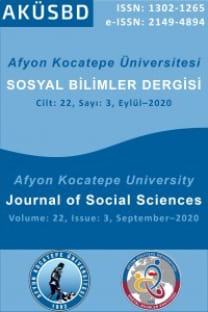Yapay Sinir Ağları ile Trafik Yoğunluğu Tahmini
Traffic Density Estimation with Artificial Neural Networks
Traffic density, vehicle speed, weather conditions working time, artificial neural networks,
___
- Abdel-Aty, M., Ekram, A.-A., Huang, H., & Choi, K. (2011). A study on crashes related to visibility obstruction due to fog and smoke. Accident Analysis & Prevention, 43(5), 1730- 1737. https://doi.org/10.1016/j.aap.2011.04.003
- Aküzüm, Prof. Dr. T., Kodal, Doç. Dr. S., Beyribey, Doç. Dr. M., Erözel, Doç. Dr. A. Z., Tokgöz, Doç. Dr. A., Selenay, Yard. Doç. Dr. F., … Yurtsever, Yard. Doç. Dr. E. (1994). Meteoroloji I. Ankara: Ankara Üniversitesi Ziraat Fakültesi Yayınları.
- Andreescu, M. P., & Frost, D. B. (1998). Weather and traffic accidents in montreal, Canada. Climate Research, 9(3), 225-230. https://doi.org/10.3354/cr009225 Andrey, J., & Yagar, S. (1993). A Temporal Analysis of rain-related crash risk. Accident Analysis and Prevention, 25(4), 465-472. https://doi.org/10.1016/0001-4575(93)90076-9
- Andrey, J., Hambly, D., Mills, B., & Afrin, S. (2013). Insights into driver adaptation to ınclement weather in Canada. Journal of Transport Geography, 28, 192-203. https://doi.org/10.1016/j.jtrangeo.2012.08.014
- Choi, S., & Oh, C. (2016). Proactive strategy for variable speed limit operations on freeways under foggy weather conditions. Transportation Research Record: Journal of the Transportation Research Board, 2551, 29-36. https://doi.org/10.3141/2551-04
- Cools, M., Moons, E., & Wets, G. (2007). Investigating the Effect of Holidays on Daily Traffic Counts: A Time Series. 19. https://doi.org/10.3141/2019-04
- Cools, M., Moons, E., & Wets, G. (2010). Assessing the ımpact of weather on traffic ıntensity. Weather Climate and Society, 2(1), 60-68. https://doi.org/10.1175/2009WCAS1014.1
- Datla, S., & Sharma, S. (2008). Impact of cold and snow on temporal and spatial variations of highway traffic volumes. Journal of Transport Geography, 16(5), 358-372. https://doi.org/10.1016/j.jtrangeo.2007.12.003
- Dey, K. C., Mishra, A., & Chowdhury, M. (2015). Potential of ıntelligent transportation systems in mitigating adverse weather ımpacts on road mobility: a review. Ieee Transactions on Intelligent Transportation Systems, 16(3), 1107-1119. https://doi.org/10.1109/TITS.2014.237145
- Eken, M., Ulupınar, Y., Demircan, M., Nadaroğlu, Y., Aydın, B., & Özhan, Ü. (2008). Klimatoloji rasat el kitabı, Çevre ve Orman Bakanlığı Devlet Meteoroloji İşleri Genel Müdürlüğü. Ankara: DMİ Genel Müdürlüğü Matbaası.
- Gültekin, Y., Demircan, M., Ulupınar, Y., & Bulut, E. (2005). Klimatoloji I. Geliş tarihi gönderen https://www.mgm.gov.tr/FILES/genel/kitaplar/klimatoloji1.pdf
- Haykin, S. (1998). Neural Networks A Comprehensive Foundation (Second Edition). Pearson Education.
- HCM. (2000). Highway Capacity Manual 2000. United States of America: Transportation research board, National Research Council.
- Janik, M., Kurihara, O., Bossew, P., (2018). Machine Learning methods as a tool to analyse ıncomplete or ırregularly sampled radon time series data, Sci. Total Environ., 630, 1155–1167, https://doi.org/10.1016/j.scitotenv.2018.02.233.
- Jung, S., Jang, K., Yoon, Y., & Kang, S. (2014). Contributing Factors to Vehicle to Vehicle Crash Frequency and Severity Under Rainfall. Journal of Safety Research, 50, 1-10. https://doi.org/10.1016/j.jsr.2014.01.001
- Keay, K., & Simmonds, I. (2005). The association of rainfall and other weather variables with road traffic volume in Melbourne, Australia. Accident Analysis and Prevention, 37(1), 109- 124. https://doi.org/10.1016/j.aap.2004.07.005
- Kopal, B. (2011). Boğaziçi Köprüsü üzerindeki trafik sıkışıklığının hız yönetimi yöntemiyle azaltılması (Yüksek lisans tezi). Bahçeşehir Üniversitesi Fen Bilimleri Fakültesi, İstanbul.
- Kyte, M., Khatib, Z., Shannon, P., & Kitchener, F. (2001). Effect of weather on free- flow speed. traffic flow theory and highway capacity 2001: highway operations, Capacity, and Traffic Control (ss. 60-68). Transportation Research Board Natl Research Council.
- Levine, N., Kim, K. E., & Nitz, L. H. (1995). Daily fluctuations in honolulu motor vehicle accidents. Accident Analysis And Prevention, 27(6), 785-796. https://doi.org/10.1016/0001- 4575(95)00038-0
- Maind, Sonali. B., & Wankar, P. (2014). Research paper on basic of artificial neural network |- Academia.edu. International Journal on Recent and Innovation Trends in Computing and Communication, 2(1), 96-100.
- Liu, A., Soneja, S. I., Jiang, C., Huang, C., Kerns, T., Beck, K., Mitchell, C., & Sapkota, A. (2017). Frequency of extreme weather events and ıncreased risk of motor vehicle collision in maryland, Science of The Total Environment, 580, 550-555. https://doi.org/10.1016/j.scitotenv.2016.11.211
- Maze, T. H., Agarwal, M., & Burchett, G. (2006). Whether weather matters to traffic demand, traffic safety, and traffic operations and flow. management and delivery of maintenance and operations services (ss. 170-176). Transportation Research Board Natl Research Council.
- MGM. (2020). Meteoroloji Genel Müdürlüğü. https://www.mgm.gov.tr (Son Erişim: 13 Şubat 2020)
- Nofal, F. H., & Saeed, A. a. W. (1997). Seasonal variation and weather effects on road traffic accidents in riyadh city. Public Health, 111(1), 51-55. https://doi.org/10.1038/sj.ph.1900297
- Öztemel, E. (2016). Yapay Sinir Ağları (4. bs). İstanbul: Papatya Yayıncılık Eğitim.
- Öztürk, K., & Şahin, M. E. (2018). Yapay sinir ağları ve yapay zekâ’ya genel bir bakış. (6/ 2), 25-36.
- Turner, S. M., Eisele, W. L., Benz, R. J., & Holdener, D. J. (1998). Travel time data collection handbook. texas: texas transportation ınstitute and the texas a&m university system.
- TÜİK. (2020). Türkiye İstatistik Kurumu. http://www.tuik.gov.tr/Start.do Son Erişim: 13 Şubat 2020)
- Unrau, D., & Andrey, J. (2006). Driver Response to rainfall on urban expressways. ıçinde driver behavior, older drivers, Simulation, User Information Systems, and Visualization (ss. 24-+). Washington: Transportation Research Board Natl Research Council.
- Usman, T., Fu, L., & Miranda-Moreno, L. F. (2012). A Disaggregate model for quantifying the safety effects of winter road maintenance activities at an operational level. Accident Analysis & Prevention, 48, 368-378. https://doi.org/10.1016/j.aap.2012.02.005
- Yan, X., Li, X., Liu, Y., & Zhao, J. (2014). Effects of foggy conditions on drivers’ speed control behaviors at different risk levels. Safety Science, 68, 275-287. https://doi.org/10.1016/j.ssci.2014.04.013
- Yılmaz, E. (2006). Karayolu trafik simülasyonu (Yüksek lisans tezi). Karadeniz Teknik Üniversitesi Fen Bilimleri Enstitüsü, Trabzon.
- ISSN: 1302-1265
- Yayın Aralığı: 4
- Başlangıç: 1999
- Yayıncı: Afyon Kocatepe Üniversitesi Sosyal Bilimler Enstitüsü
Melis Seray ÖZDEN YILDIRIM, Nida ATES
Kamusal Alanda Sanat ve Sanat Eserleri
Sınıf Öğretmenlerinin Perspektifinden Değerler ve Değerler Eğitimi Uygulamalarının Değerlendirilmesi
Vedat AKTEPE, Hilal KESER, Şükran Ezgi ŞEREF
Sürdürülebilir Kültürel Miras Yönetimi: Turizm Paydaşlarına Yönelik Bir Araştırma
Reşad Emre ÖZGÜNEŞ, Düriye BOZOK, Derman KÜÇÜKALTAN
Teknoloji Tabanlı Talebe-Dayalı Taşımacılık İş Modellerine Geçiş: Karşılaştırmalı Bir Araştırma
